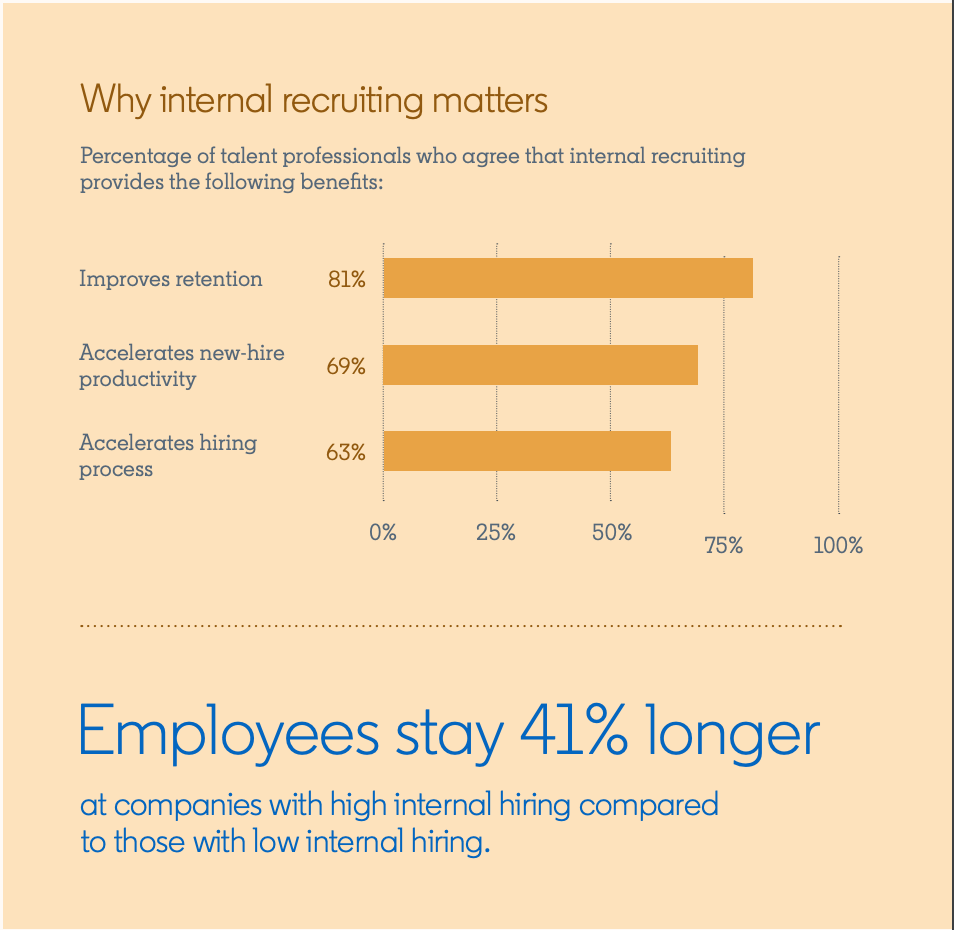Key takeaways:
- Quiet hiring is one of the biggest trends in the talent landscape this year. The vast majority — over 70% — of talent professionals said it’s increasingly important to their companies.
- Internal mobility could be the key to decreasing turnover and saving time and resources.
- Hiring managers want to hold onto their top talent, which could stifle upward mobility. It’s important to show managers that encouraging employee growth only benefits the organization.
- In order for internal mobility to be successful, a formalized process could be necessary. When employees learn about open roles through networking, diversity suffers.
- Upskilling is a key component of internal mobility, so collaboration between Learning and Development and Talent Acquisition is important.
“Quiet hiring” might be 2023’s biggest workplace trend as enterprises turn their attention inward to upskill their own employee pool.
LinkedIn’s 2020 Global Talent Trends Report called this the “rebirth of the internal hire,” indicating that after a decades-long run of largely seeking external candidates to fill talent gaps, internal recruiting is making a big comeback.
In fact, in 2020, 73% of responding talent professionals told LinkedIn that internal recruiting is increasingly important to their companies.
Chuck Edward, Corporate Vice President of Human Resources at Microsoft, was quoted in the study, saying, “For all the focus on mapping the external talent marketplace, the irony is that there’s not enough focus placed on the talent underneath one’s own roof.”
Promoting internal mobility is a cost-effective approach that can bring a number of benefits to both the organization and its employees, but it’s not without its barriers and challenges.
Let’s dive into the quiet hiring trend — its benefits and drawbacks.
Improved retention and decreased cost per hire
Coming off the heels of the Great Resignation and a current hiring slowdown, employers are focused on employee retention, and rightly so: Turnover is expensive and inefficient.
In fact, Gartner found that turnover due to a lack of future career opportunities costs an average-sized organization $49 million per year, indicating that a lack of upward mobility could cost enterprises millions.
Improved employee retention is cited as one of the largest benefits of promoting internal mobility.
LinkedIn also found that companies with strong internal mobility cultures enjoy higher levels of employee retention. On average, people stay 41% longer at companies with high internal hiring compared to those with low mobility.
Company Cultural Change Can’t Happen Overnight
Quiet hiring might be this year’s biggest hiring trend, but employees aren’t seeing it (yet).
LinkedIn’s 2023 Workplace Learning Report found that just 15% of employees say their companies have encouraged them to move into a new role.
LinkedIn also found that internal mobility is largely driven by the employees themselves. Talent marketing professionals reported that up to 72% of employees find internal roles on job boards, meaning that recruiting teams are passive in the process.
If the benefits are clear and executives want to see internal mobility, where is the disconnect?
During a confidential conversation hosted by the Talent Marketing Board, members said encouraging a culture change is never easy, and convincing hiring managers that their employees may benefit from a position change can be incredibly hard.
A few members — senior recruitment marketing and employer brand leaders at billion-dollar brands — shared how they encourage the belief that the level of organizational talent is what’s most important: Managers can buy into building the company instead of getting possessive over team members.
The global trends report elaborated on this challenge, saying that companies are facing a catch-22 when it comes to quiet hiring. Talent marketing professionals said managers clinging to talent was the largest barrier to internal recruiting.
Understandably, managers don’t want to lose their best team members, but surveys tell us employees will look for greener pastures if their career growth is stifled.
Chuck Edward told LinkedIn, “None of us get to ‘own’ an employee. If someone’s hiring an employee from your team, that’s not poaching. That’s two managers collaborating for the win of the company.”
This isn’t the only barrier to increasing internal hiring — it could also make it more difficult to diversify your workforce. When internal recruiting occurs organically through professional networks, it can reinforce existing groups and biases.
To combat this pitfall, formalizing an internal hiring process could be the key to success.
Where Should You Begin?
Journalist Laura Hilgers suggested in a LinkedIn article that building an internal talent marketplace is necessary to bring visibility to open positions.
She wrote, “It’s a good idea to consider a technology platform that functions as an internal talent marketplace. Ideally, this would also track and even assess employee skills and provide information on mentors, training, gig projections, and rotations.”
Not only do employees want to see internal opportunities, but they also want to see how others have advanced their careers within the company.
During the Talent Marketing Board’s private conversation, one Board Member shared how they’ve capitalized on career growth success stories by highlighting how skill sets can be cultivated and lead to roles the employee never expected.
LinkedIn also found that companies stand to gain from collaboration between Talent Acquisition and Learning and Development teams.
“Working in silos, recruiters opt for external hires rather than the lower-cost option of recruiting internally and upskilling. Meanwhile, L&D leaders create learning programs that aren’t always tied to specific roles or needs,” the study states.
Despite the inefficiencies, just 23% of L&D professionals said they partner with recruiting to identify skill gaps and hard-to-fill roles. A stronger partnership between these teams could be a win for both employees and the enterprise.
Learn From Other Talent Marketing Leaders
It’s clear that even the biggest workplace trends can be difficult to implement internally, but talent marketing leaders can stay ahead of an evolving talent landscape by sharing and learning together.
In less than an hour, Talent Marketing Board members came together for a confidential benchmarking session on quiet hiring and how to overcome the barriers.
This is just a small preview of the many conversations and resources shared within the community.
Get in touch below to learn how you can benchmark with leaders like you.



